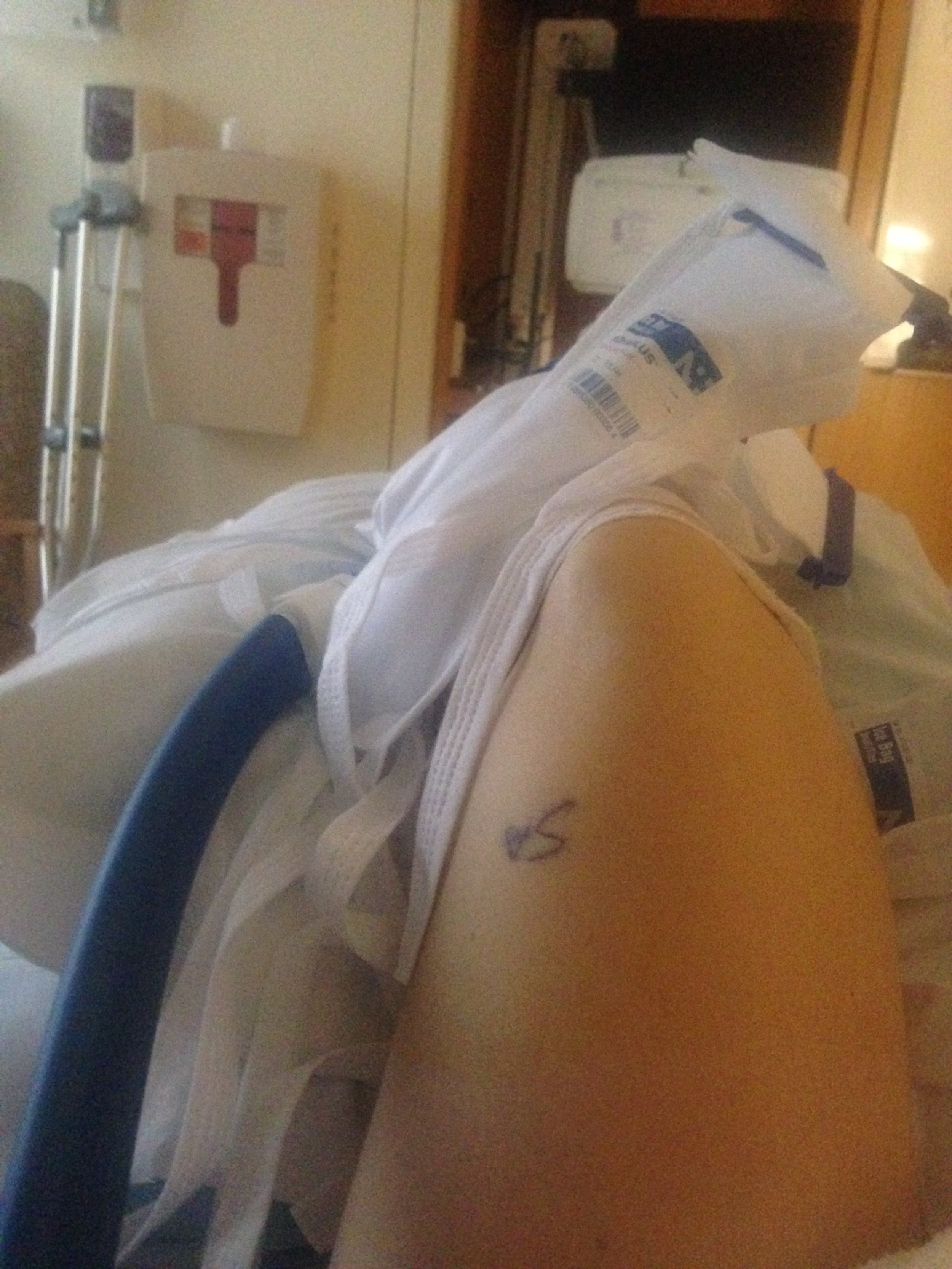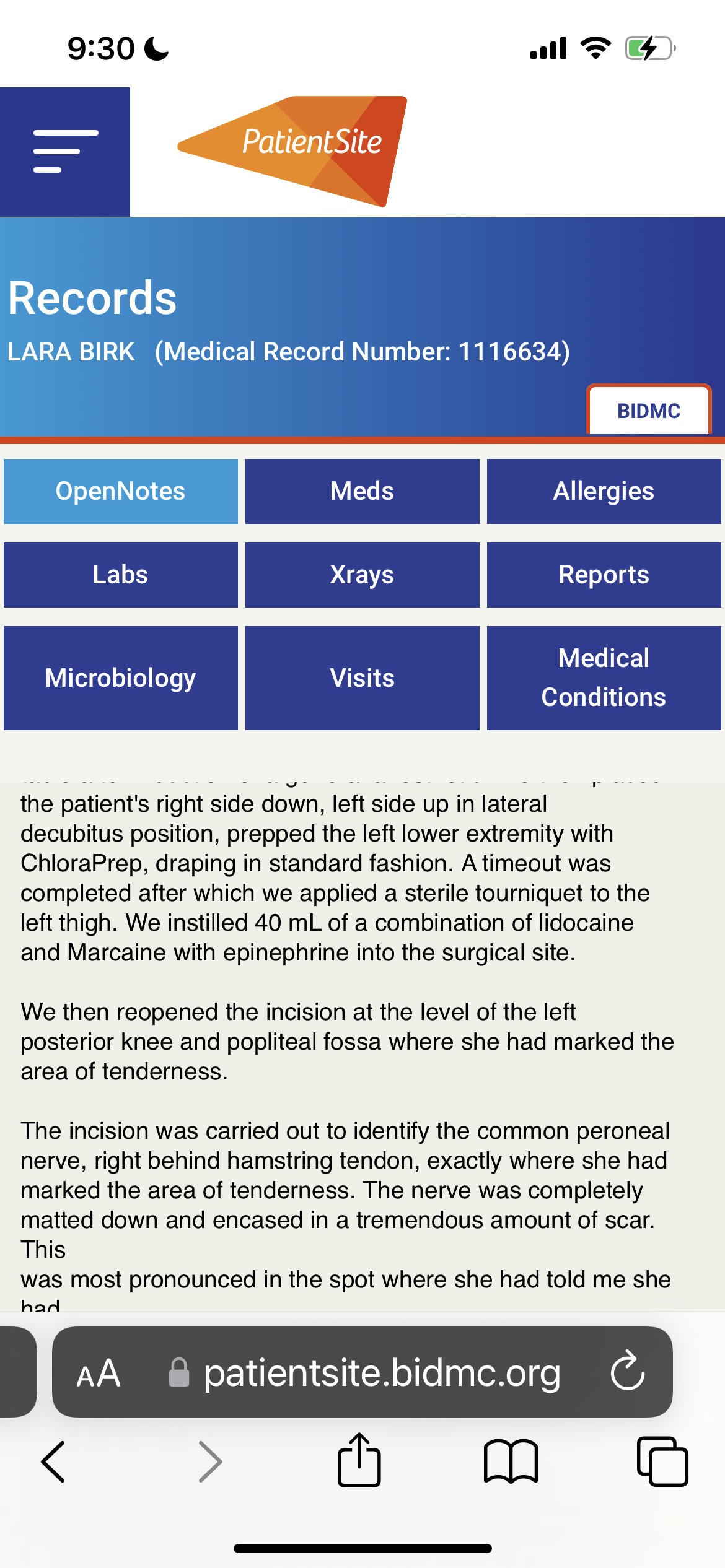
Lara’s Acute Exertional Compartment Syndrome
* Warning: Graphic Images below.


Below: (Graphic) Photographs of Lara’s Right Leg from age 16 after several emergency surgeries to save the leg from misdiagnosed Acute Exertional Compartment Syndrome - Lara’s case was written up and was only the 2nd recorded case in the medical literature. (Note: there was an error in their reporting of the status of the left leg, as they had not gotten updated information at the time of the publication.)
This condition (Acute Exertional Compartment Syndrome) began when I was playing soccer at age 16, taped up for what I thought were “shin splints.” The ER doctors sent me home calling me a crybaby twice, before a wise doctor who had seen Acute Compartment Syndrome in soldiers in the Korean War realized what it was and called my mother to bring me in immediately for emergency surgery.
It was a bit too late to save a lot of my lower leg muscles and tissues. The surgeons first tried putting in 2 mini inch-long slits (fasciectomy) to relieve the pressure. When that did not bring down the emergency level acute pressures, I had to have another emergency surgery to cut from knee to ankle. At this point the pressure had been so intense the insides of my leg quite literally burst outward such that her wound was 5 inches wide at its widest. The pictures you see were not even the worst of it; they were taken several weeks after the initial ‘explosion’. The doctor would not allow me to see my leg until several weeks after the original surgeries because he believed it would be too traumatizing for me to see my leg; so my nurses maintained a visual guard so I could not see it until it was healed enough to look at. My sister said she would look at it for me. She gallantly stood there during one of my excruciating hour long daily sessions of ‘debridement’ of the necrotic tissue (removal of dead tissue one bit at a time). When they unwrapped the last of the bandages, she ran from the room and vomited. I will never forget what the necrosis smelled like.
In any case, this all led to many subsequent surgeries to try to save my leg from amputation with grafts and the like. I was in the hospital for 6 weeks that first hospitalization. The surgeon told me I was a ‘lucky girl’ because he’d decided at the very last minute not to amputate and to give the leg a fighting chance.
I kept my right leg but to this day I have a lot of muscle tissue missing, especially the muscles that lift your foot and others that help you keep your balance. There is a protruding bump like a second knee on my right leg, a bit of deformity caused by the losses sustained in that leg and the remaining muscle bunching upward like a rubber band.
What happened after many surgeries on the right leg, I was finally up out of a wheelchair onto my feet about a year after this all began. I was on crutches using my left leg as the “good leg” of course when the syndrome erupted in my left leg this time. The doctors said I had won the (bad) lottery twice, what were the odds!? I had to have first a fasciectomy (two little slits) on the left leg, and when that didn’t work, the full knee to ankle cut. When even that was not sufficient to keep the pressures from going dangerously high, they had to go in again and remove the entire fascia of the muscles in two of the compartments, anterior and lateral. This successfully kept me from ever having compartment syndrome again.
However, at that point I had had a lot of surgeries. Over time, I had several post-surgical neuromas along the nerve that had been compromised. Right at the time of 9/11, I had to have a surgery to remove the many neuromas along the deep peroneal nerve. Later, I had to have surgery to unentrap and then kill the superficial nerves that had become entrapped by scar tissue adhesions.
Still later, the motor branch of the left leg peroneal nerve got into trouble. The extraordinary pain whenever I moved my left leg turned out to be massive amounts of scar tissue adhesions tying the nerve to the knee tendon. “No wonder it hurt every time you moved your leg!” said the surgeon. I had to have not one but two surgeries to unentrap the peroneal nerve. By this time, I had developed a severe knee contracture in which I could not straighten my knee all the way. I still have this contracture to this day, 8 years later.
Before surgeries 16 and 17, I also had many cortisone shots to that spot behind the left knee, including a hydrodissection gone wrong (they had not secured my shaking leg before the needle went into the nerve!) — and this was all done without my consent. All of those injuries and irritations to the peroneal nerve, in that same quarter-sized spot behind the left knee, plus the two surgeries on the nerve itself, the surgeon reported there was micro damage to the nerve after its having been compressed for several years. We believe at this point, the nerve has been traumatized and grown more sensitive over time, and it is chronically inflamed. My manual therapist felt in that area and guessed there was some additional new scar tissue adhesions. No one would ever operate on this area again. The surgeon who did surgery 17 told me that every medical mentor he had (including the surgeon of surgery 16) was telling him not to do this surgery.
LaIa live with chronic nerve pain every minute of every day. It does feel less intense with my dedicated and ongoing practice of mindbody methods. The pain gets to a 2-5 for long stretches of weeks or even months, and then something will tweak the sensitive nerve (an accidental stretch) and send the pain into the 7-8+ territory, sometimes for weeks or months on end.
In the good periods, I can go for long walks in the woods. In the bad periods, I must use crutches to walk and still the pain is 7-8+. The pain during these times profoundly limits my mobility, but even more, the sensitivity and local inflammation of the nerve means that after the first tweak, the nerve is even more apt to further tweaks because of its already inflamed state. During the days between tweaks, I slowly improve, but any subsequent accidental stretch can set the recovery clock back to zero again. The option that took care of the previous nerve pain (killing / cutting and burying the nerves) is out of the question for this nerve because it is a motor nerve necessary for walking, lifting one’s foot and toes, etc.
MindBody methods have helped me enormously, in spite of 17 surgeries and all the ‘structural’ ramifications of the many years of medical fallout. In the meantime, I have developed a vast number of skills and internal resources in this process, which are also instrumental in my own professional practice helping others who live with chronic pain. I call it MindBody Empowerment because it is, for me, not supposed to be about “recovery" from or a “cure” for chronic pain. Some people, who have more neuroplastic types of symptoms, their symptoms go away entirely. But for those of us with more complicated medical conditions, this work is still incredibly powerful and healing.
Healing just means something different for us. And I want to give at least one voice so that we too can be heard and healed, whatever that looks like.
Right now, I am in one of the difficult stretches, back on crutches, and yet still profoundly empowered by my work in the mindbody sphere. This is the healing path. What I have been through these last 33 years has given me so many learnings, I cannot enumerate them. But I do want to share them. That is why I do this work, even though I too remain on this path alongside so many others. There is nothing wrong with that. Wounded healers offer what no one else can: we get it. I get it. More than I could ever express in words. And I am not ashamed, I am proud.
More Photographs of Lara’s Right Leg from age 16


















